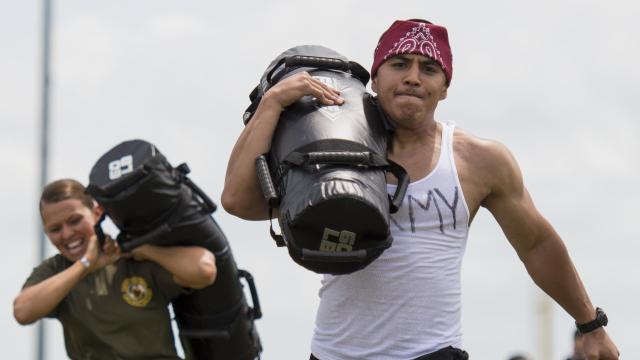Sandbags are easy to make, but hard to get right. Sand even comes in a bag, if you buy it at the store, but drop that on the ground two or three times and the sand and the bag will part ways. This matters because a durable sandbag is one of the best workout tools you can have.
You can hoist, throw and lug your sandy friend in dozens of different ways. Deadlift it. Carry it on your shoulder. Clean it, jerk it, and do a burpee on your way down, and call that a man-maker. Throw it in front of you, and run after it so you can throw it again. You need a sturdy sandbag to stand up to all that.
So after extensively perusing make-your-own-sandbag information online, and testing out some techniques ourselves, we have some recommendations for the best way to build a sandbag.
The Filler
Sand, right? That’s one option. But sand loves to leak out of seams and holes. With that said, it’s also dense, which is great if you want to make a bag that’s very heavy, or very small.
Pea gravel weighs and costs about the same as sand, but it’s less sandy. It may not feel as comfortable on your shoulder, though. Larger grades of gravel can work, but the bigger the rocks, the more your shoulder will feel like it’s been beat up by a bag of rocks.
Two lighter options are worth considering. Wood pellets, manufactured as fuel for wood stoves, are about half the density of sand but with much larger pellets. Expect to find a little bit of sawdust in the bag, but not much. They’re another cleaner-than-sand option.
Rubber mulch is lightweight, but it’s worth considering if you want to build a sandbag (mulchbag?) that’s physically large but doesn’t weigh a ton. Rubber mulch is more expensive than the options above.
Here are the key numbers for these four options, including the prices I found when I went shopping:
-
Sand: about $6-$8 for 20kg
-
Pea gravel: about $8-$9 for 20kg
-
Wood pellets: about $10-$20 for 20kg
-
Rubber mulch: about $15 for 10kg
The Liner Bags
What does the sand go in? Not a canvas bag—that’s the next step. Whichever filler you chose, you’ll want to put it inside of something that is sand-proof, waterproof (optional but recommended), and that can be securely closed.
If your sandbag gets wet, it will get heavier. That might be a plus! But it could also get moldy, muddy, or gross. If you plan to use it outdoors, something waterproof is best.
-
Sand bags meant for building dikes in floodwaters
-
Inner tubes from car tires (use these alone and they’re called Bulgarian training bags).
-
Large zip-top freezer bags (double or triple bagged).
-
Heavy-duty “contractor” garbage bags (3 mil or more), ideally double or triple bagged.
Think for a moment about how many liner bags you’d like. If you have 23kg of sand, you might want to make a 9kg bag and a 14kg bag, so that you have three different workout options (using one or the other, or both).
Don’t stuff these bags full, or else you’re just making tight little bricks. A key feature of a sandbag is that it slumps around and conforms to the shape of your shoulder. Leave a little room in whichever liner bag you use. To seal your chosen bag, tie a knot if you can, and then apply lots of duct tape to seal the seams and stabilise the bag.
Contractor garbage bags are probably the best option if you don’t have inner tubes handy; they’re cheap on a per-bag basis, at $20 to $30 for a box of 24. They’re large enough that you’ll have a lot of excess plastic. Wrap it snugly around the bag (or trim to size, if you prefer) and tape down the edges to make a self-contained package.
The Outer Bag
The best sandbags (in my opinion) are shaped like a duffel bag, with two short handles parallel to each other—which is perpendicular to the way duffel bag handles usually run. Brute Force sandbags are one commercial brand made this way. If you fall in love with a particular brand, you can always buy their empty bags. But if you’re making your own, I’m guessing you can’t drop $US80 ($113) on an empty bag.
So, look to military surplus bags. They’re well-made, usually of canvas, and can often be had cheap. Look for either a duffel bag, or a plain drawstring barracks bag.
Or thrift yourself a bag. Avoid bags with stiff bottoms, little plastic feet, or seams with piping (those seams will burst open the first time you throw it). If you have to choose between a sturdy-looking bag with any of those doodads, versus a flimsier one that’s plain and simple, go with the simple one.
No store-bought duffel bag will have the handles in the ideal configuration, but you can fix that with a needle and thread. You’ll need:
-
Heavy duty upholstery or quilting thread
-
A medium sized sewing needle
-
Scissors
-
A thimble (optional)
Cut one of the duffel’s straps about two inches from where it’s attached to the bag. Cut the other strap on the diagonally opposite side. Now you have two free straps, and you can trim each to length and sew each one to the other’s stub. (Use backstitch, and sew a square with an X in the middle.)
If the bag has any other straps, cut them off or secure them with duct tape. Then enjoy! Don’t forget to check on the liner bags every few workouts, just to make sure nothing has sprung a leak. Add more duct tape, or extra layers of garbage bags, as needed.

Comments